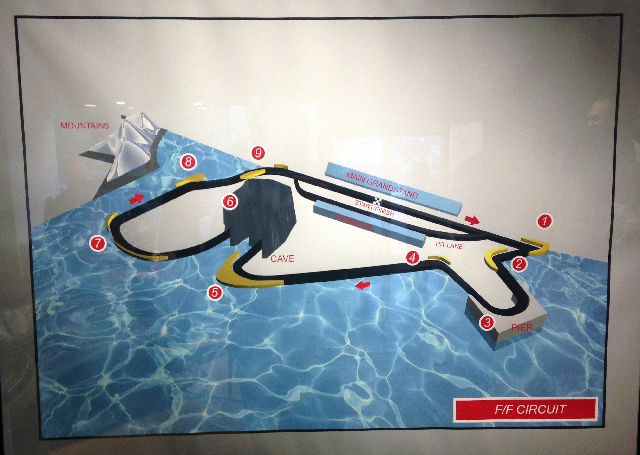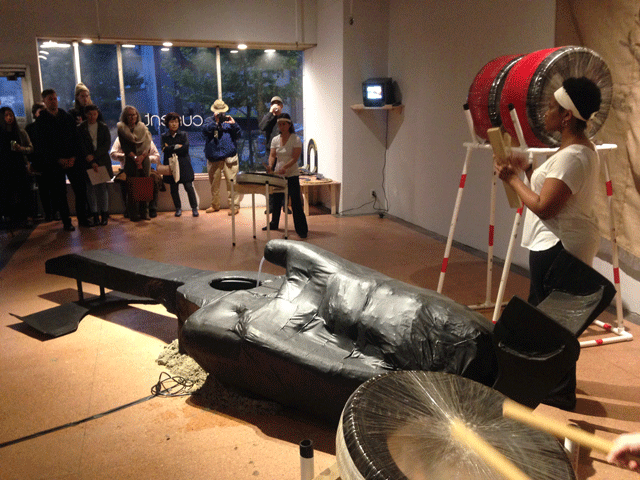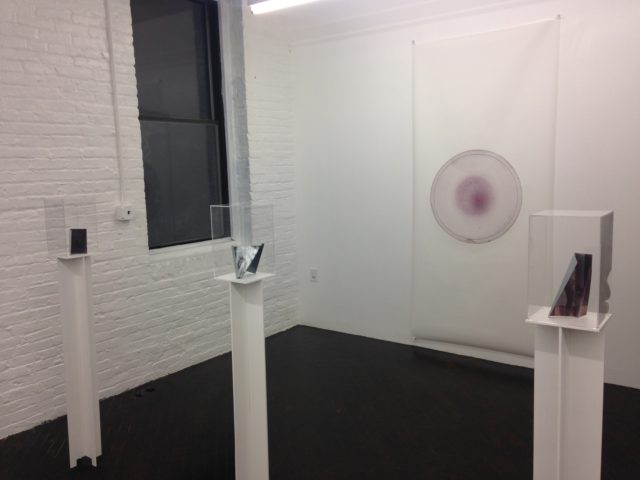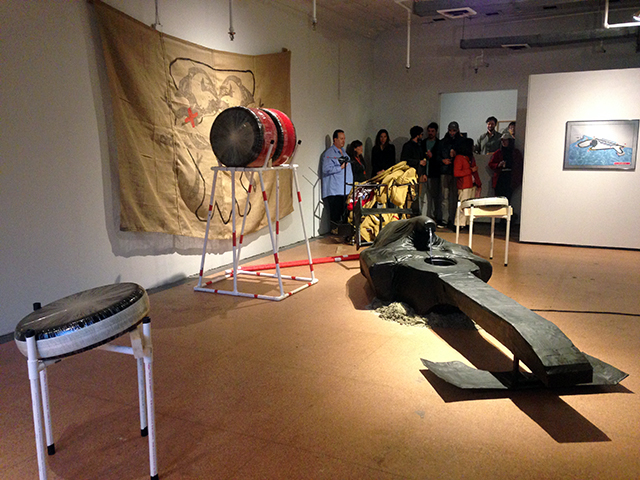The next week is a good time to do some art-seeing on the westside of downtown Baltimore. Michael Jones McKean’s commission from The Contemporary has transformed an old department store into a dystopian museum and it’s teriffying and great. You can check it out by appointment until May 31st, when it will be deinstalled. Luckily some of the city’s strongest artist-run spaces are within a few blocks of the show and also tend to accommodate by-appointment viewings as well. I checked out three openings last weekend: Beki Basch’s trippy Vision Quest Lundi: Flush / Flood at Current Gallery, Hein Koh’s technicolor wonderland Joy & Pain at Platform, and the group show Photo Flesh at Terrault Contemporary featuring three international genre-bending photographers from the Birmingham School of Art.
Beki Basch: Vision Quest Lundi: Flush/Flood
 Current Gallery
Current Gallery
421 N. Howard Street, Baltimore MD
May 13 – June 4
What do Icelandic-inspired vision quests, Formula 1 racers pissing their pants, and a Japanese video game about taiko drums have to do with one another? That’s a question you might find yourself wondering in Beki Basch’s endearingly idiosyncratic installation Vision Quest Lundi: Flush / Flood. A functioning model racetrack winds through the gallery’s storefront; massive nearly-symmetrical burlap flags bear paintings with references to maps, Hokusai prints, and shamanic imagery; sleek CGI renderings depict a video-game-like landscape; and the project space has been transformed into a gift shop full of souvenirs. In the middle of it all, a lumpy black form resembling a wheel-less racecar from the world of Alien lays prone on the floor. A small tube protrudes from its humpback, slowly trickling water into a jet black toilet bowl where a cockpit would be.
That sculpture—titled “Automated Physiology=Situation for Transcendence”—is so oddly sinister and sympathetic at the same time that it’s like an attention black hole. During the opening, Basch wheeled a cart around it, packed with PVC pipes and sturdily-constructed bags evocative of camping gear. The cases opened to reveal car tires, each wrapped with clear plastic tape. She assembled these components into a circle of free-standing drums, each one positioned roughly in relationship to wherever a wheel should be on the racecar. A group of young women beat the drums, while the artist lit incense in cast iron-and mirror holders, as if conducting a ritual to bless or resurrect a beached whale with magic. It was weird as fuck.
 Apart from the loving craftsmanship in so much of the work, that unabashed weirdness is what makes this show one of the most rewarding art-viewing experiences in town right now. Basch’s work is perfectly comfortable being rooted in obscure personal references to the point of inscrutability—despite the social aspect of the performances and implied interaction—and that’s refreshing. When I asked her about the project, she explained that this is the latest “chapter” in her Vision Quest Lundi (the Icelandic word for “puffin”) body of work. The series loosely follows ideas of adventure and self-realization through quests. To Basch, the image of the racecar driver endlessly driving in circles (even past the point of pissing oneself) shares a rhythmic logic with the drumming video game (itself rooted in Japanese mythology and ritual). The anthropomorphised cartoon drum from the video game becomes “this little mascot of the idea of transforming through repetition. He is the wheel of the racecar that spins around and around and then all of a sudden he becomes who he is, but his protruding limbs make the car swerve and crash. Why? Well no reason really. It’s silly. He’s a little trickster. That’s what they do.”
Apart from the loving craftsmanship in so much of the work, that unabashed weirdness is what makes this show one of the most rewarding art-viewing experiences in town right now. Basch’s work is perfectly comfortable being rooted in obscure personal references to the point of inscrutability—despite the social aspect of the performances and implied interaction—and that’s refreshing. When I asked her about the project, she explained that this is the latest “chapter” in her Vision Quest Lundi (the Icelandic word for “puffin”) body of work. The series loosely follows ideas of adventure and self-realization through quests. To Basch, the image of the racecar driver endlessly driving in circles (even past the point of pissing oneself) shares a rhythmic logic with the drumming video game (itself rooted in Japanese mythology and ritual). The anthropomorphised cartoon drum from the video game becomes “this little mascot of the idea of transforming through repetition. He is the wheel of the racecar that spins around and around and then all of a sudden he becomes who he is, but his protruding limbs make the car swerve and crash. Why? Well no reason really. It’s silly. He’s a little trickster. That’s what they do.”
Photo Flesh
Alberto Condotta, Jodie Wingham, and Andrea Jaeger

Installation view with Andrea Jaeger’s “No Longer Titled 3” print on rice paper and Jodie Wingham’s prints on folded aluminum.
Maryland Art Place building, 3rd Floor
218 W. Saratoga Street, Baltimore MD
Three international photography scholars from Birmingham School of Art; Alberto Condotta (Italy), Jodie Wingham (UK), and Andrea Jaeger (Germany) stretch the medium’s display conventions with multimedia works. In Alberto Condotta’s case, this can mean digital photographs of manipulated prints that exist solely on individual tablet displays or painterly weavings made from strips of prints. Andrea Jaeger’s macro photos of what appear to be cracks in glazed ceramic objects read like gorgeously detailed watercolors when printed larger-than-life on rice paper. They’re one of those artworks best appreciated from a viewing distance of just inches, despite their large dimensions. In some pieces, Wingham prints on metal surfaces, creating folded sculptural works that seem to break images into sequential panels.
Wingham’s series “Wearing the Punctum” comprises a series of touch-related images printed directly onto tiny concave aluminum “bowls”. On the wall, they feel precious. But they’re intended to be worn like jewelry with the assistance of tiny magnets and cost a mere $20. It’s a steal.
Hein Koh: Joy & Pain

Platform Gallery
116 W. Mulberry Street, Baltimore MD
May 13 – June 24th
Giant eyes cry glitter spandex tears, rainbows arc across the gallery, and anthropomorphised cartoon stars hold hands. Hein Koh’s installation of stuffed fabric sculptures recall children’s show puppets or the myriad grown-up artists who have appropriated the aesthetic to subversive ends. Here, though, the work is pretty wholesome (despite numerous anatomical allusions). Koh’s work is largely informed by (and one gets the impression made for) her young twin daughters. That’s pretty cute, but adults enjoyed the funhouse on a different level too.
Don’t overlook Koh’s small drawings, which feel oddly more personal and compelling than the larger, more labor-intensive fibers pieces. The recurring breast/eye motif and symmetrical references to the body throughout so much of Koh’s work seem to hint obsessively at some just-out-of-grasp anxiety. Are crying and lactation related processes? Who knows? Bodies are weird.





Comments on this entry are closed.